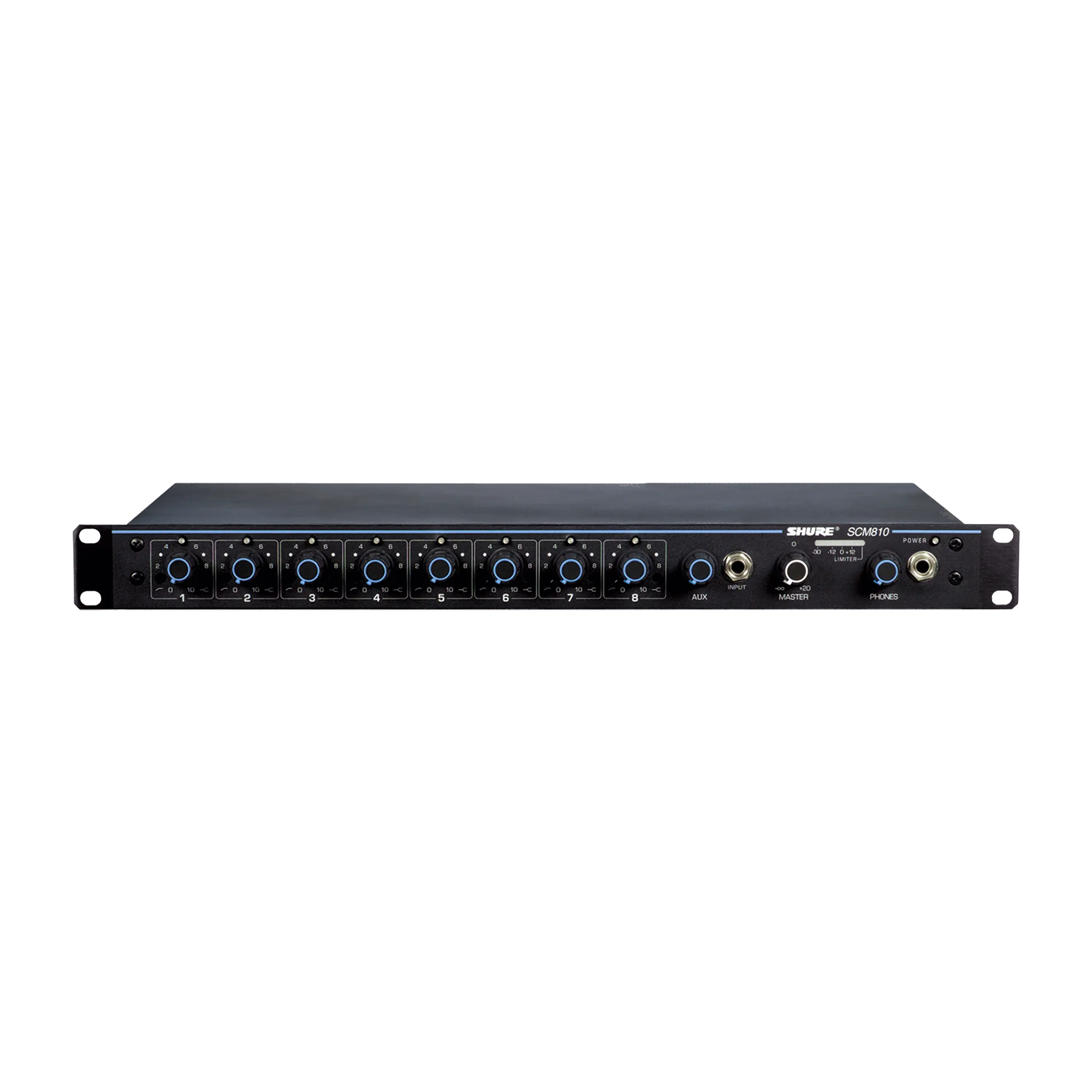Automatic Microphone Mixers: When You Need Them

Typical Applications:
- Houses of Worship
- Teleconferencing
- Videoconferencing
- Panel Discussions
- Boardrooms
- Distance Learning
- Hotel Sound
- Courtrooms
Microphone mixers, also known as voice-activated or sound-activated microphone mixers, have one fundamental function: to attenuate (or reduce in level) any microphone that is not being addressed, and conversely, to rapidly activate any microphone that is addressed by a talker. In general, any speech sound reinforcement system that uses four or more microphones should include an automatic mixer.
With too few open mics, some talkers sound clear, while others seem far away. With too many open mics, there is a greater likelihood of feedback and too much background noise is added, making it hard for talkers to be heard clearly. And often, a talker's voice will be picked up by more than one microphone, resulting in poor audio quality.
All audio systems face the same problems whenever multiple open microphones are needed:
- Build-up of background noise and reverberation
- Reduced gain before feedback
- Comb filtering
These problems can plague boardrooms, city council chambers, conference centers, churches, teleconferencing rooms, talk shows, anywhere multiple microphones are used. Since audio quality rapidly deteriorates as the number of open microphones increases, the solution is to keep the minimum number of microphones open that will handle the audio. Automatic mixers address these concerns by opening mics as soon as they are needed and attenuating them when they are not in use.
Allan Soifer in Sound & Video Contractor provides the back-story: "The need for many mics to be active at once was first perceived by those A/V contractors who serviced government legislative chambers, city council halls, hotel function rooms, and so on. The common problem with trying to operate and control the levels on even six mics is obvious to anyone who has attempted it — one never has enough hands nor is quite fast enough to really ride herd on levels. If one turns all the mics on, both feedback and excessive background noise can occur."
Let's revisit the potential issues caused by multiple open mics and how automatic mixers address them:
The first problem of multiple open microphones is the excessive pickup of background noise, which adversely affects the audio quality of the sound system.
Here's an example:
Consider a city council meeting with eight members and eight microphones. Only one member is talking at a time. If all eight microphones are open when only one microphone is needed, the audio output will contain the background noise and reverberation of all eight microphones.
This means the audio signal will contain substantially more background noise and reverberation than if only the talker's microphone was open. Speech clarity and intelligibility always suffer as background noise and reverberation increase. In this example, the audio output of eight open microphones would contain 9 dB more background noise and reverberation than a single open microphone. To the human ear, the noise would sound roughly twice as loud when all eight microphones were open.
In addition to only activating microphones that are being addressed, an automatic mixer uses a NOMA (Number of Open Microphones Attenuator) circuit, or equivalent, to help minimize the build-up of background noise and reverberation. This circuit proportionally reduces the overall output of the mixer whenever the number of open microphones increases. A well-designed automatic mixer maintains a consistent level of background noise and reverberation, regardless of how many or how few microphones are active.
The NOMA circuit also plays a major role in controlling the second major problem with multiple open microphones, reduced gain-before-feedback. Acoustic feedback, characterized by an obnoxious howling or screeching sound, can be a problem with any sound system using microphones. Most sound systems are operated below the point where feedback occurs. The margin for stable (feedback-free) operation reduces every time another microphone is opened.
Comb filtering is phase cancellation that occurs when a single sound source is picked up by more than one microphone at different distances from the source, and those signals are combined at the mixer.

Since sound travels at a finite speed, the resultant frequency response of the combined microphone signals is considerably different from that of a single microphone. The frequency response chart of the combined signals resembles the teeth of a hair comb, thus the name. The aural result sounds hollow, diffuse, and thin. An automatic mixer significantly reduces comb filtering by keeping the number of open microphones to an absolute minimum. Certain models of automatic mixers further reduce comb filtering by employing a circuit that will only allow one microphone to turn on for a given sound source.
Selecting a Microphone Mixer
There are dozens of automatic mic mixers on the market. Expert Soifer (S&VC) suggests you look for features like these:
- Ability to discriminate between speech and ambient noise
- Quick, seamless microphone activation
- Automatically adaptive threshold
- Automatic level adjustment based on the number of active microphones
- Ability to override automatic functions on individual channels as required
- Ability to expand with the needs of the facility.

Shure offers two automatic mixers: SCM810 and SCM410. They are networkable, configurable, and as simple to connect as opening the box, plugging in and connecting the microphones. They both work with all professional wired and wireless microphones for seamless automatic mixing right out of the box.
What to Remember: Automatic Microphone Mixers
The primary function of an automatic mixer is to keep unused microphones turned off and to instantaneously activate microphones when needed.
- The application is speech
- Using an automatic mixer will: improve gain before feedback, reduce audio degradation caused by superfluous open microphones, and control the build-up of background noise
- Keeping the number of open microphones to a minimum always improves overall audio and quality
- The additional control circuitry on automatic mixers can provide a variety of additional functions: audio privacy switches, chairperson control of all microphones, illuminated indicators of microphone status, and automatic video camera selection based on microphone activation
Need more information? Visit www.shure.com



